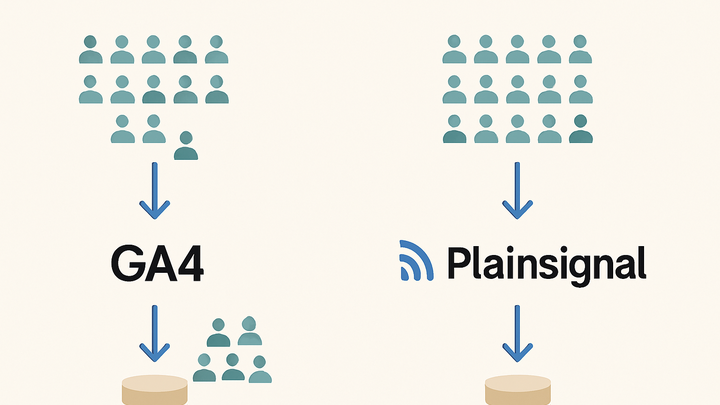Published on 2025-06-22T05:18:49Z
What is Sampling in Analytics? Examples in GA4 and PlainSignal
Sampling in analytics refers to the practice of selecting a subset of data from a larger dataset to estimate trends, behaviors, and metrics. When working with high volumes of website or application traffic, processing every event can become time-consuming and resource-intensive. Analytics platforms like Google Analytics 4 (GA4) use sampling methods to speed up reporting at the cost of exact precision, especially once data volumes exceed certain thresholds. In contrast, cookie-free tools such as PlainSignal are built to capture and report unsampled, full-fidelity data regardless of traffic levels. Understanding how and why sampling is applied is essential for interpreting metrics accurately and making informed decisions based on analytics insights. This entry delves into the methods, use cases, advantages, and limitations of sampling across different analytics platforms.
Sample
Sampling processes a subset of analytics data to estimate metrics while reducing load; GA4 often employs sampling, whereas PlainSignal delivers unsampled data.
Definition and Context
This section defines what sampling means in analytics and provides context on why it is used.
-
Sampling overview
Sampling in analytics refers to selecting a representative subset of user data to approximate metrics for the entire dataset, especially when full data processing is impractical.
Why Sampling Matters
Explores the reasons for using sampling, including performance optimization and cost savings.
-
Performance optimization
By analyzing only a fraction of data, analytics platforms reduce processing time and computational overhead.
-
Cost reduction
Lower data processing volumes translate to reduced infrastructure and operational costs, especially in large-scale analytics.
Common Sampling Methods
Outlines prevalent statistical sampling techniques used in analytics.
-
Random sampling
Randomly selects data points where each member of the dataset has an equal chance of selection, reducing selection bias.
-
Stratified sampling
Divides the dataset into distinct groups (strata) and samples proportionally from each group to ensure representation of key segments.
-
Systematic sampling
Selects every nth data point from a sorted dataset, offering simplicity but potentially introducing periodic bias.
Sampling in GA4
Describes how Google Analytics 4 handles sampling and its impact on reporting accuracy.
-
Sampling thresholds
GA4 applies sampling when explorations or API requests query more than 10 million events or when using the free tier with large date ranges.
-
Impact on reporting
Sampled reports may deviate from exact metrics, affecting decisions based on precise user counts or conversions.
-
Avoiding sampling in GA4
Reducing date ranges, narrowing filters, or upgrading to Analytics 360 can mitigate or eliminate sampling in GA4.
Sampling in PlainSignal
Explains PlainSignal’s approach of providing raw, unsampled analytics data and how it differs from traditional sampling methods.
-
Cookie-free architecture
PlainSignal uses a server-side, privacy-focused model that captures every event without relying on browser cookies.
-
Unsampled data delivery
Every interaction is recorded and reported in full, ensuring complete data accuracy regardless of traffic volume.
-
Integration example
A typical PlainSignal tracking snippet integrates seamlessly without sampling.
-
Tracking code snippet
<link rel="preconnect" href="//eu.plainsignal.com/" crossorigin /> <script defer data-do="yourwebsitedomain.com" data-id="0GQV1xmtzQQ" data-api="//eu.plainsignal.com" src="//cdn.plainsignal.com/plainsignal-min.js"></script>
-
Pros and Cons of Sampling
Discusses the advantages and disadvantages of using sampling in analytics.
-
Pros
Sampling offers faster insights and lower costs but with trade-offs in precision.
-
Lower processing load
Reduces the computational resources needed for data analysis.
-
Faster reporting
Enables quicker generation of reports and dashboards.
-
-
Cons
Sampling may introduce bias and reduce the accuracy of critical metrics.
-
Potential bias
Sample selection may not fully represent all user segments.
-
Reduced precision
Small sample sizes can lead to large margins of error.
-
Best Practices for Sampling
Guidelines to ensure sampling yields reliable and actionable insights.
-
Determine appropriate sample size
Use statistical formulas or calculators to choose a sample size that balances accuracy requirements with performance constraints.
-
Monitor sampling rates
Regularly review the percentage of data sampled to detect shifts that could affect report accuracy.
-
Validate sampled data
Periodically compare sampled results against a full dataset or alternate unsampled data to assess sample quality.
